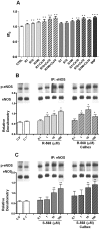Calcimimetic R-568 and its enantiomer S-568 increase nitric oxide release in human endothelial cells
- PMID: 22295103
- PMCID: PMC3266284
- DOI: 10.1371/journal.pone.0030682
Calcimimetic R-568 and its enantiomer S-568 increase nitric oxide release in human endothelial cells
Abstract
Background: Calcimimetics, such as R-568, are thought to activate G protein-linked Ca(2+)-sensing receptor (CaSR) by allosterically increasing the affinity of the receptor for Ca(2+) allowing for efficient control of uremic hyperparathyroidism. Several recent studies suggest they possess additional vascular actions. Although it has been postulated that calcimimetics may have a direct effect on CaSR in the blood vessels, further studies are needed to elucidate their vascular CaSR-dependent versus CaSR-independent effects.
Methodology/principal findings: Focusing on human umbilical vein endothelial cells (HUVECs), we studied the CaSR expression and distribution by Immunofluorescence and Western Blot analysis. CaSR function was evaluated by measuring the potential effect of calcimimetic R-568 and its enantiomer S-568 upon the modulation of intracellular Ca(2+) levels (using a single cell approach and FURA-2AM), in the presence or absence of Calhex-231, a negative modulator of CaSR. To address their potential vascular functions, we also evaluated R- and S-568-stimulated enzymatic release of Nitric Oxide (NO) by DAF-2DA, by Nitric Oxide Synthase (NOS) radiometric assay (both in HUVECs and in Human Aortic Endothelial Cells) and by measuring eNOS-ser1177 phosphorylation levels (Immunoblotting). We show that, although the CaSR protein was expressed in HUVECs, it was mainly distributed in cytoplasm while the functional CaSR dimers, usually localized on the plasma membrane, were absent. In addition, regardless of the presence or absence of Calhex-231, both R- and S-568 significantly increased intracellular Ca(2+) levels by mobilization of Ca(2+) from intracellular stores, which in turn augmented NO release by a time- and Ca(2+)-dependent increase in eNOS-ser1177 phosphorylation levels.
Conclusions/significance: Taken together, these data indicate that in human endothelium there is no stereoselectivity in the responses to calcimimetics and that CaSR is probably not involved in the action of R- and S-568. This suggests an additional mechanism in support of the CaSR-independent role of calcimimetics as vasculotrope agents.
Conflict of interest statement
Figures





Similar articles
-
Calcimimetics increase CaSR expression and reduce mineralization in vascular smooth muscle cells: mechanisms of action.Cardiovasc Res. 2014 Feb 1;101(2):256-65. doi: 10.1093/cvr/cvt249. Epub 2013 Nov 11. Cardiovasc Res. 2014. PMID: 24217682
-
Calcium sensing receptor expression in ovine amniotic fluid mesenchymal stem cells and the potential role of R-568 during osteogenic differentiation.PLoS One. 2013 Sep 9;8(9):e73816. doi: 10.1371/journal.pone.0073816. eCollection 2013. PLoS One. 2013. PMID: 24040082 Free PMC article.
-
Positive and negative allosteric modulators promote biased signaling at the calcium-sensing receptor.Endocrinology. 2012 Mar;153(3):1232-41. doi: 10.1210/en.2011-1426. Epub 2011 Dec 30. Endocrinology. 2012. PMID: 22210744
-
Calcimimetics and hyperparathyroidism.Curr Opin Investig Drugs. 2004 Oct;5(10):1080-5. Curr Opin Investig Drugs. 2004. PMID: 15535429 Review.
-
Functional proteins involved in regulation of intracellular Ca(2+) for drug development: the extracellular calcium receptor and an innovative medical approach to control secondary hyperparathyroidism by calcimimetics.J Pharmacol Sci. 2005 Mar;97(3):355-60. doi: 10.1254/jphs.fmj04007x6. Epub 2005 Mar 17. J Pharmacol Sci. 2005. PMID: 15781990 Review.
Cited by
-
Activation of the calcium-sensing receptor before renal ischemia/reperfusion exacerbates kidney injury.Am J Transl Res. 2015 Jan 19;7(1):128-38. eCollection 2015. Am J Transl Res. 2015. PMID: 25755835 Free PMC article.
-
Calcimimetic R-568 vasodilatory effect on mesenteric vascular beds from normotensive (WKY) and spontaneously hypertensive (SHR) rats. Potential involvement of vascular smooth muscle cells (vSMCs).PLoS One. 2018 Aug 9;13(8):e0202354. doi: 10.1371/journal.pone.0202354. eCollection 2018. PLoS One. 2018. PMID: 30092054 Free PMC article.
-
Role of the calcium-sensing receptor in regulating vascular function.J Cell Commun Signal. 2025 Feb 5;19(1):e70004. doi: 10.1002/ccs3.70004. eCollection 2025 Mar. J Cell Commun Signal. 2025. PMID: 39912052 Free PMC article. Review.
-
CaSR as a Therapeutic Target and Tool in Human Dental Pulp: A Concise Review and Novel Hypothesis.Oral Health Prev Dent. 2020 Jul 4;18(2):295-300. doi: 10.3290/j.ohpd.a42688. Oral Health Prev Dent. 2020. PMID: 31204395 Free PMC article. Review.
-
Stimulation of calcium-sensing receptors induces endothelium-dependent vasorelaxations via nitric oxide production and activation of IKCa channels.Vascul Pharmacol. 2016 May;80:75-84. doi: 10.1016/j.vph.2016.01.001. Epub 2016 Jan 6. Vascul Pharmacol. 2016. PMID: 26772767 Free PMC article.
References
-
- Drueke TB, Ritz E. Treatment of secondary hyperparathyroidism in CKD patients with cinacalcet and/or vitamin D derivatives. Clin J Am Soc Nephrol. 2009;4:234–241. - PubMed
-
- Brown EM, Gamba G, Riccardi D, Lombardi M, Butters R, et al. Cloning and characterization of an extracellular Ca(2+)-sensing receptor from bovine parathyroid. Nature. 1993;366:575–580. - PubMed
-
- Nagano N. Pharmacological and clinical properties of calcimimetics: calcium receptor activators that afford an innovative approach to controlling hyperparathyroidism. Pharmacol Ther. 2006;109:339–365. - PubMed
-
- Aida K, Koishi S, Tawata M, Onaya T. Molecular cloning of a putative Ca(2+)-sensing receptor cDNA from human kidney. Biochem Biophys Res Commun. 1995;214:524–529. - PubMed
-
- Smajilovic S, Tfelt-Hansen J. Calcium acts as a first messenger through the calcium-sensing receptor in the cardiovascular system. Cardiovasc Res. 2007;75:457–467. - PubMed
Publication types
MeSH terms
Substances
LinkOut - more resources
Full Text Sources
Miscellaneous

